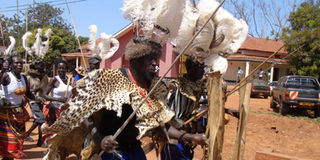Agago teenage pregnancies blamed on traditional dances

Jubilation. A dance troupe performs the Acholi traditional Otole dance during last year’s Acholi cultural festival in Gulu Municipality. Many young girls in the sub-region elope with men while attending late night traditional ceremonies. PHOTO BY JULIUS OCUNGI
What you need to know:
- Mr Douglas Peter Okello, the Omoro District chairperson, suggested that there is a need to involve stakeholders such as religious and cultural leaders in the fight against teenage pregnancies and embracing family planning uptake.
Gulu/Agago. Agago District leaders have blamed the rising cases of teenage pregnancies in the area on the popularity of traditional ceremonies.
At 28 per cent, the district has one of the highest teenage pregnancy rates in the country, above the national average of 25 per cent.
According to the District Health Officer, Dr Emmanuel Otto, many young girls have fallen prey to men while attending traditional ceremonies such as courtship dances which at times continue until late in the night.
“The courtship dance [Larakaraka] is well advertised in my district. Youth, especially during school holidays and the dry season, go for this type of dance. It goes on for many days and during such period, you find that a boy or man may elope with a young girl and the result is the girl is likely to get pregnant,” Dr Otto says.
He also expresses fear that with the introduction of the annual Acholi cultural festival, which attracts thousands of people, the cases of teenage pregnancy are bound to rise.
Dr Otto adds that low education levels have also significantly contributed to the problem.
A 2018 survey on regional uptake of contraceptives in northern Uganda indicates there is still low family planning uptake among women.
The survey, which was conducted by Makerere University School of Public Health (MakSPH), reveals that 37.5 per cent for every 100 women aged between 15 and 49 are using modern family planning method in the region.
However, Prof Frederick Makumbi, the lead investigator, while disseminating the findings in Gulu Town last Friday, said there is an improvement compared to the 2016 Demographic Health Survey that put the family planning uptake at 35 per cent.
“There is an increasing number of women who are using long term methods. This has been largely attributed to their availability in all the health facilities,” Prof Makumbi said.
He said the survey also indicates that for every 100 women in northern Uganda who visit health facilities, 71 per cent of them have been told about other methods of family planning and their side effects.
“The finding is an indicator that the quality of services from the perspective of the women is reasonably high and it has been improving. There is an improvement of modern family planning in northern Uganda,” Prof Makumbi said.
He, however, acknowledged that the socio-economic status and education level still affect the level of modern family uptake.
Mr Douglas Peter Okello, the Omoro District chairperson, suggested that there is a need to involve stakeholders such as religious and cultural leaders in the fight against teenage pregnancies and embracing family planning uptake.
He noted that religious and traditional leaders need to be equipped with skills of communicating to teenagers and women on use of family planning and abstinence from sex to reduce cases of unwanted pregnancies.



